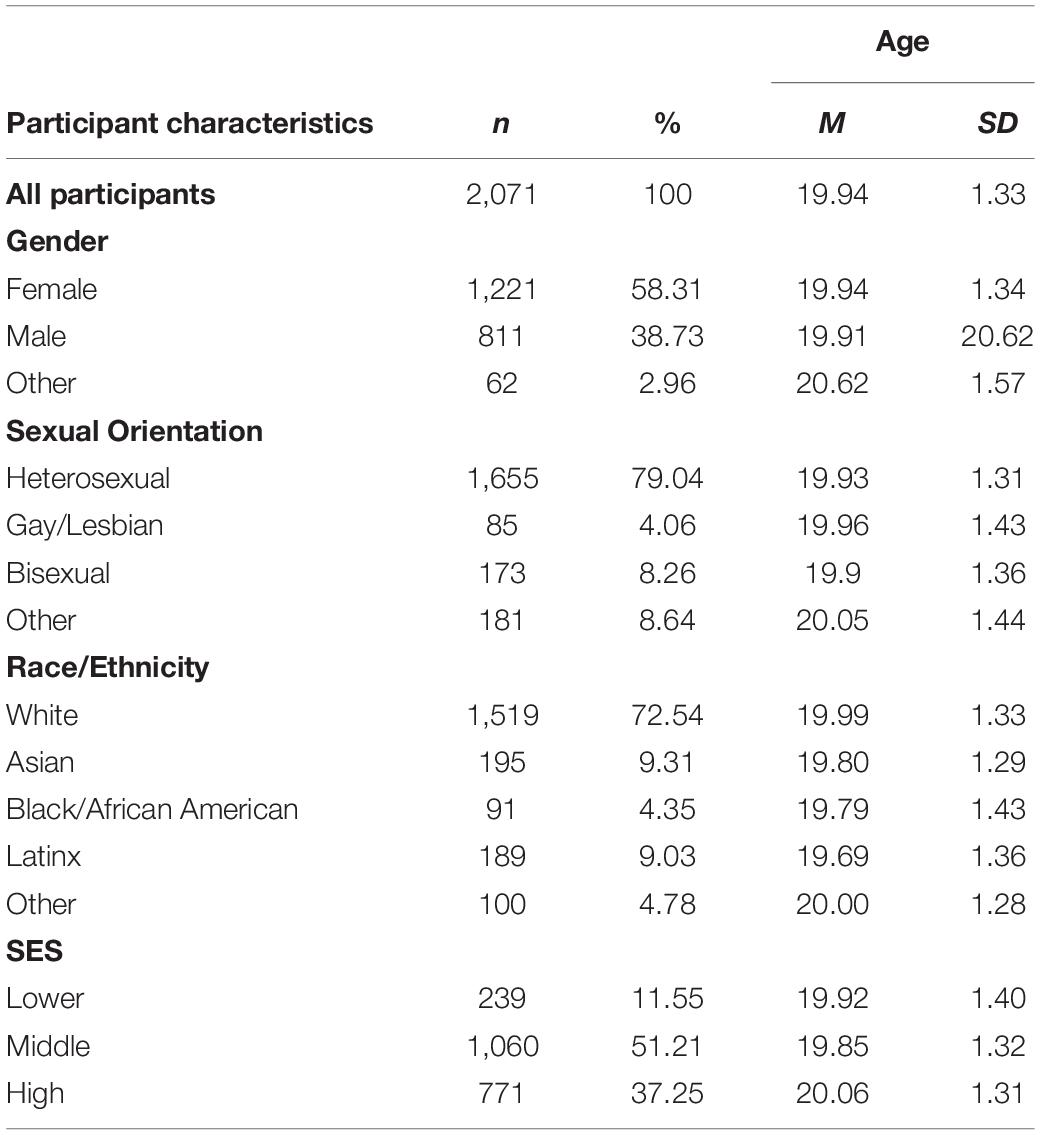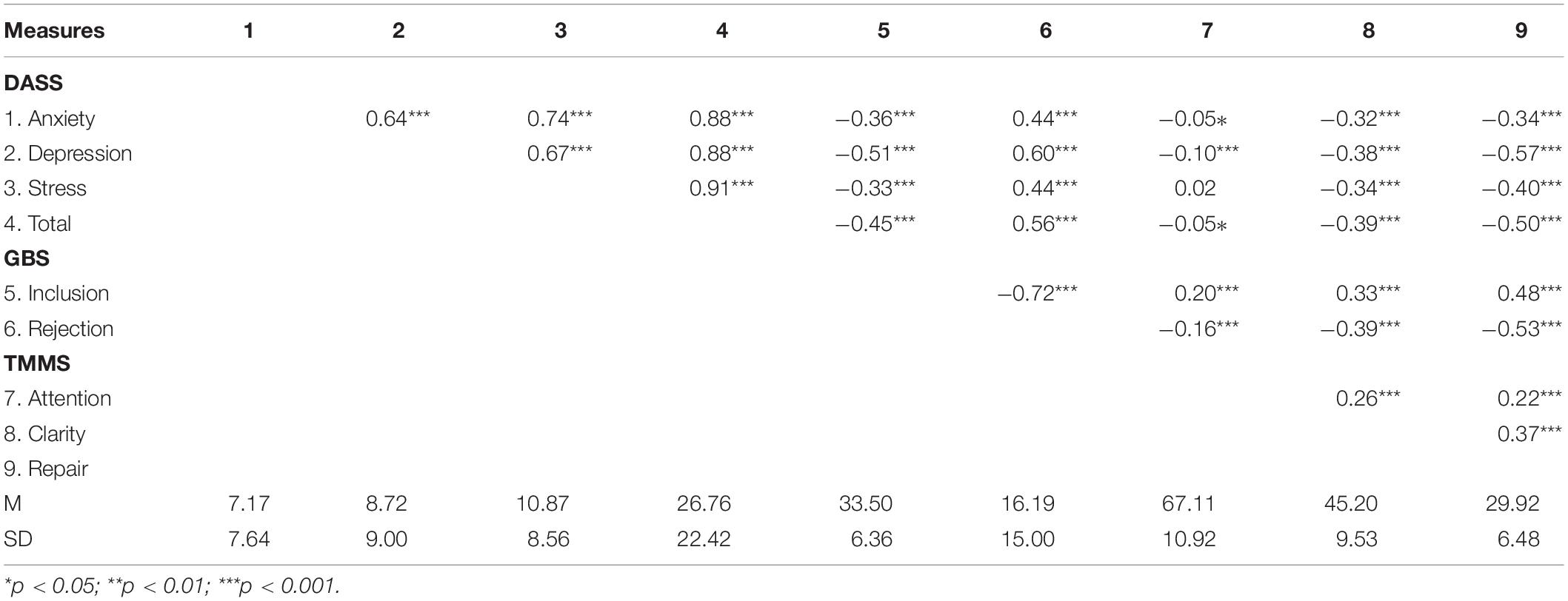- 1Department of Psychology, Middlebury College, Middlebury, VT, United States
- 2Department of Psychological Science, University of Vermont, Burlington, VT, United States
Mental health problems are prevalent amongst today’s college students and psychosocial stress has been identified as a strong contributing factor. Conversely, research has documented that emotional intelligence (EQ) is a protective factor for depression, anxiety and stress (mental health problems). However, the underlying mechanism whereby EQ may support stronger mental health is currently not well understood. This study used regression analyses to examine the hypothesis that belongingness (inclusion, rejection) partially mediates the effects of EQ (attention, clarity, repair) on psychological well-being in a large sample (N = 2,094) of undergraduate students. Results supported the mediation hypotheses for all three EQ components and highlighted that the effects of rejection on psychological well-being were particularly strong. In line with prior research, our results indicate that prevention and intervention efforts with college students could explicitly target EQ skills in an effort to reduce perceived rejection and promote student well-being.
Introduction
Mental Health Problems
High rates of mental health problems have been documented amongst college students (for a discussion see Auerbach et al., 2016; Xiao et al., 2017). For example, one study reported that 17% of surveyed students met diagnostic criteria for major depressive disorder (Selkie et al., 2015). Using the Depression, Anxiety, Stress Scale (DASS-21) Mahmoud et al. (2012) found 29% of college students had elevated levels of depression, while 27% had elevated anxiety and 24% elevated stress. The elevated rates of depression, anxiety and stress (mental health problems) are also noted in national data such as those from the American College Health Association’s National College Health Assessment (ACHA-NCHA; American College Health Association, 2019). In their survey of undergraduate students, ACHA reports 26% of students reported feeling so depressed in the past 30 days that it was difficult to function, while 43% of students reported feeling overwhelmed by anxiety in the same period of time (American College Health Association, 2019). While recognizing that many factors contribute to the high rates of psychopathology of college students, past research indicates that psychosocial stress is associated with mental health problems (e.g., Dusselier et al., 2005; Drum et al., 2009). The transition to college is associated with the developmental challenge of changes to existing relationships (Hurst et al., 2013) while college students also experience increased exploration in the context of declining social support systems (Conley et al., 2014). Given the close link between psychosocial stress and student mental health, applied work has explicitly targeted psychosocial functioning of college students (e.g., Pratt et al., 2000; Conley et al., 2013).
Emotional Intelligence
In light of the increasing mental health problems and the influence of psychosocial factors for college students, it has become increasingly important to understand the role of emotional intelligence of college students as researchers and practitioners begin exploring opportunities for interventions. Emotional intelligence (EQ) includes “the abilities to accurately perceive emotions, to access and generate emotions so as to assist thought, to understand emotions and emotional knowledge, and to reflectively regulate emotions” (Mayer et al., 2004, p. 197). The variability in EQ suggests that some individuals are better able to perceive, correctly identify, and regulate emotions than others (Mayer and Salovey, 1997). Various strands of research suggest that higher levels of EQ are associated with various aspects of psychological well-being, including greater levels of subjective well-being (Sánchez-Álvarez et al., 2015), life satisfaction (Extremera and Fernández-Berrocal, 2005), and better mental health (Martins et al., 2010; Ruiz-Aranda et al., 2012). Further, research has also shown that different aspects of EQ are related to an individual’s ability to perform certain tasks, including academic (Parker et al., 2004; Costa and Faria, 2015) and athletic achievement (Perlini and Halverson, 2006). Focusing specifically on undergraduate students, higher levels of interpersonal and intrapersonal intelligence have been linked to greater college retention (Parker et al., 2006) and end-of-year GPA among first-year students (Schutte et al., 1998; Parker et al., 2004).
Moving beyond emotional adaptation and individual competence, EQ also appears to be involved in the shaping of social functioning. In a study of undergraduate students, researchers found that participants’ EQ was related to their satisfaction with social relationships (Lopes et al., 2003). Specifically, participants who reported having higher levels of emotion regulation abilities were more likely to also report having positive relationships with others, perceiving support from parents, and were less likely to have negative interactions with a friend (Lopes et al., 2003). These results were largely supported by a second study in which an individual’s self-reported emotion regulation abilities were significantly correlated with self-reported positive interactions with friends (Lopes et al., 2004). A noteworthy strength of this study is that the individual’s self-reported emotion regulation abilities were also significantly correlated with friends’ reports of interpersonal functioning (Lopes et al., 2004). Research has demonstrated that higher scores of EQ are associated with more social acceptance and fewer experiences of rejection (Kokkinos and Kipritsi, 2012), as well as larger and more fulfilling social support networks (Ciarrochi et al., 2001). Taken together, these results support the view that the multiple aspects of EQ are associated with better social functioning. Stated differently, individuals who are better able to recognize and regulate their own emotions appear better able to establish and maintain healthy social relationships with peers and parents.
Sense of Belonging
An important aspect of social functioning is a sense of belonging. The role of perceived belongingness in psychological well-being has also been explored. The seminal work of Baumeister and Leary (1995) provides a valuable theoretical background for this notion. According to the Need to Belong Theory (NBT; Baumeister and Leary, 1995), human beings are motivated to establish a certain amount of stable and positive interpersonal relationships (Baumeister and Leary, 1995). There is extensive evidence to support the NBT. There is a strong positive relation between an individual’s sense of interpersonal belonging and their ratings of happiness and subjective well-being (McAdams and Bryant, 1987). While a lack of social bonds, or explicit feelings of social exclusion, contribute to feelings of anxiety (Baumeister and Tice, 1990; Leary, 1990; Williamson et al., 2018), other mental health outcomes, including depression, loneliness, and social anxiety, are greatly reduced when college students experience a sense of belonging (O’Keeffe, 2013; Stebleton et al., 2014; Raymond and Sheppard, 2018). The need to belong may be particularly pronounced in college students and appears to serve a protective function when satisfied. Yet, despite evidence that EQ is associated with higher quality social interactions with peers (Brackett et al., 2004; Lopes et al., 2004), the relation between EQ and belongingness among college students is not well understood.
The Current Study
High rates of mental health problems are well documented in today’s college population. In an effort to support the well-being of undergraduate students, predictors of mental health problems need to be identified and fostered. In recognizing that psychosocial stressors are contributing to some of the psychological distress reported by college students, aspects of EQ and belongingness have emerged as correlates of mental health problems. To our knowledge, no study to date has examined the association between the different aspects of EQ, belongingness, and mental health in college students. Additionally, elucidating the effects of the EQ subscales (attention, clarity, repair) on mental health in college students could provide an opportunity to direct interventions that target specific emotional skills. Given that greater levels of each of the aspects of EQ have been associated with better interpersonal relationships, this study tested the hypothesis that belongingness (whether measured as level of acceptance, rejection, or both) mediates the effects of the EQ subscales (attention, clarity, repair) on psychological well-being.
Materials and Methods
Procedure
The Middlebury Institutional Review Board (IRB) approved all study procedures. An ongoing longitudinal study, the College Student Mental Health Pathways study, is a study exploring social/emotional development and mental health outcomes among undergraduate college students. The present analysis utilizes data from wave two, collected in 2019. All students at two liberal arts colleges in the United States received an email inviting them to participate in a study about student stress and mental health. Students who clicked on the link in the email were directed to an informed consent page, approved by the primary author’s IRB. Students were able to consent after reading the consent form by selecting one of two radio buttons, ‘I consent to participate’ or ‘I do not consent to participate’. A total of 2,094 students completed wave two of the study, which resulted in a participation rate of 45.86%. At the completion of the survey, students could enter their contact information into a separate survey to participate in a raffle to win a gift card (values ranged from $25–100).
Measures
Demographics
Participants reported demographic information including gender, race/ethnicity, perceived socioeconomic status (SES), and sexual orientation. A majority of the sample identified as female (58.31%, n = 1,221), 38.73% (n = 811) identified as male and 2.96% (n = 62) non-binary. The majority of respondents identified as heterosexual, 79.04% (n = 1,655), while 4.06% (n = 85) identified as gay/lesbian, and 8.26% (n = 173) identified as bisexual. Seventy-three percent (n = 1,519) of the sample identified as White, followed by Asian 9.31% (n = 195), Latinx 9.03% (n = 189), and those identifying as mixed race or other 4.78% (n = 100). Perceived SES status included 51.21% (n = 1,060) of participants identifying as middle SES, 37.25% (n = 771) as high SES, and 11.5% (n = 239) as lower SES. The average age of the students was 19.94 (SD = 1.33). Demographics are presented in Table 1.
Depression, Anxiety, and Stress
The DASS-21 scale (Henry and Crawford, 2005) was used to assess depression, anxiety, and stress. The scale can be utilized as a sum score or as three individual scales (i.e., depression, anxiety, stress). Participants were asked to respond to statements indicating how frequently in the past week they experienced any of the symptoms. Response sets and associated values for scoring were as follow: (0) did not apply to me at all, (1) applied to me to some degree, or some of the time, (2) applied to me a considerable degree or a good part of time, (3) applied to me very much or most of the time. Each scale contained seven items, with associated scores ranging from 0 to 21. Items in the measure include: “I found it difficult to work up the initiative to do things” (depression), “I felt I was close to panic” (anxiety) and “I found it hard to wind down” (stress). Due to the strong intercorrelations between depression, anxiety and stress (see Table 2), the composite DASS score was used to better capture the totality of the mental health experience. Cronbach’s alpha for the full scale was 0.93.
Belongingness
The General Belongingness Scale (GBS; Malone et al., 2012) was used to measure experiences of belongingness. The GBS contains two subscales: Inclusion and Rejection. Each subscale contains six items and participants responded to each item using a 7-point Likert scale ranging from strongly disagree to strongly agree. Sample items include: “I feel accepted by others” (Inclusion) and “When I am with other people, I feel like a stranger” (Rejection). Inclusion and Rejection are potentially orthogonal; it is possible for a respondent to be high (or low) on both, reflecting the simultaneous experience of being included in some circumstances and rejected in others. Cronbach’s alphas were 0.92 for the Inclusion subscale and.89 for the Rejection subscale.
Emotional Intelligence
The Trait Meta Mood Scale (TMMS; Salovey et al., 1995) was used to measure three forms of emotional intelligence: attention to emotions (Attention), emotional clarity (Clarity) and repair of emotions (Repair). The TMMS includes 30 items, 13 for Attention, 11 for Clarity, and 6 for Repair. Participants were asked to use a five-point Likert scale (strongly disagree to strongly agree) to indicate their agreement with each item. Example items include: “I pay a lot of attention to how I feel” (Attention), “Sometimes I can’t tell what my feelings are” (Clarity), and “I try to think good thoughts no matter how badly I feel” (Repair). Cronbach’s alphas for the subscales were: 0.87 for Attention, 0.86 for Clarity, and 0.81 for Repair.
Statistical Procedures
Three parallel mediation models were independently estimated using the PROCESS macro (Hayes, 2017), using pre-defined Model 4. Consistent with the original conceptualization of the TMMS as consisting of independent subscales (Attention, Clarity, and Repair), and with more recent factor analyses that found low levels of cross-loading amongst empirically observed factors (Palmer et al., 2003), the models were estimated separately in order to illustrate the independent contributions of each subscale. Models were estimated both with and without demographic covariates. Covariates tested were gender identification, socioeconomic status, sexual orientation, and race/ethnicity, all dummy coded to allow for their inclusion in ordinary least squares regression modeling. The resulting models including covariates did not differ in significance, sign, or approximate coefficient value from the models that did not include covariates. For ease of interpretation the models represented do not show the covariates.
Results
Bivariate correlations were estimated for variables of interest and are shown in Table 2. Note that statistically significant (and meaningfully large) correlations were observed amongst most of the variables, with only the relationships between Attention and Stress having a p > 0.05, and only the relationships between Stress and Anxiety and the DASS Full Scale having an estimated p > 0.01. The correlations between the DASS Full Scale and the DASS subscales are presented for completeness, but should be interpreted with caution, since the full scale consists of the sum of the subscales, and thus the measures are not independent.
Tables 3–6 show differences in the variables of interest by gender (Table 3), socioeconomic status (Table 4), sexual orientation (Table 5), and race/ethnicity (Table 6). Significance was calculated using ANOVAs, and is marked with subscripts on all three tables at the p < 0.05 level.
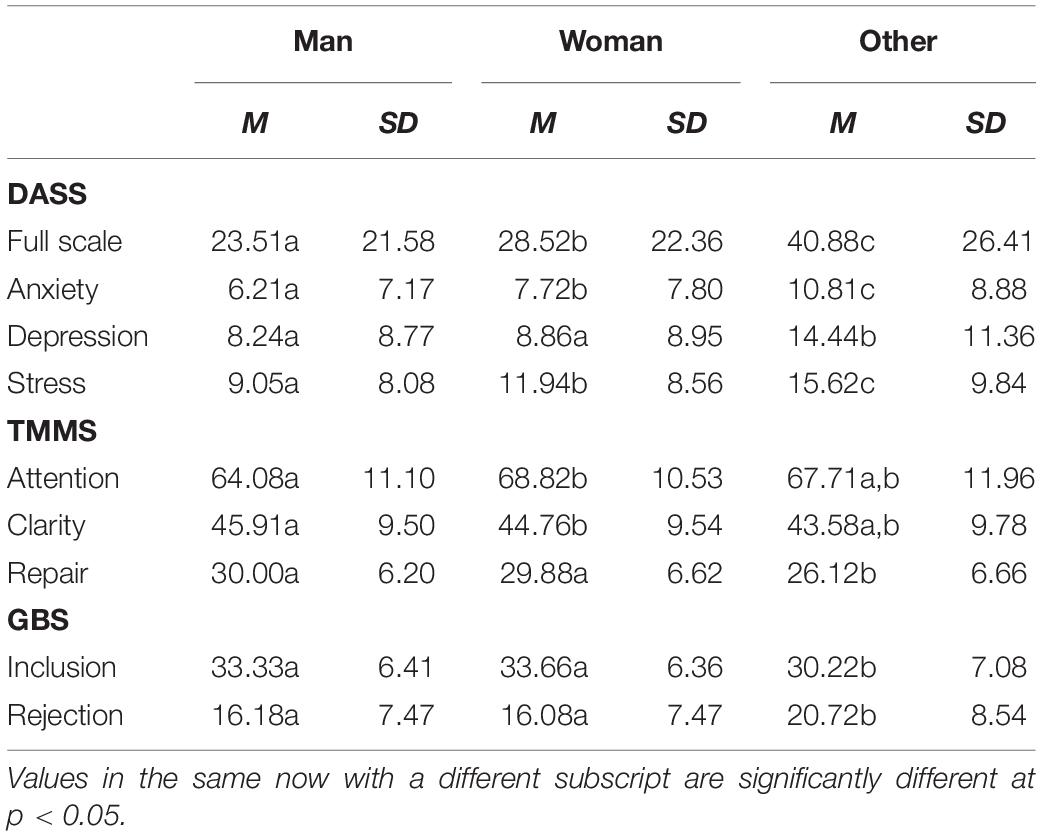
Table 3. Gender differences in Depression Anxiety Stress Scale (DASS), Trait Meta Mood Scale (TMMS) and General Belongingness Scale (GBS).
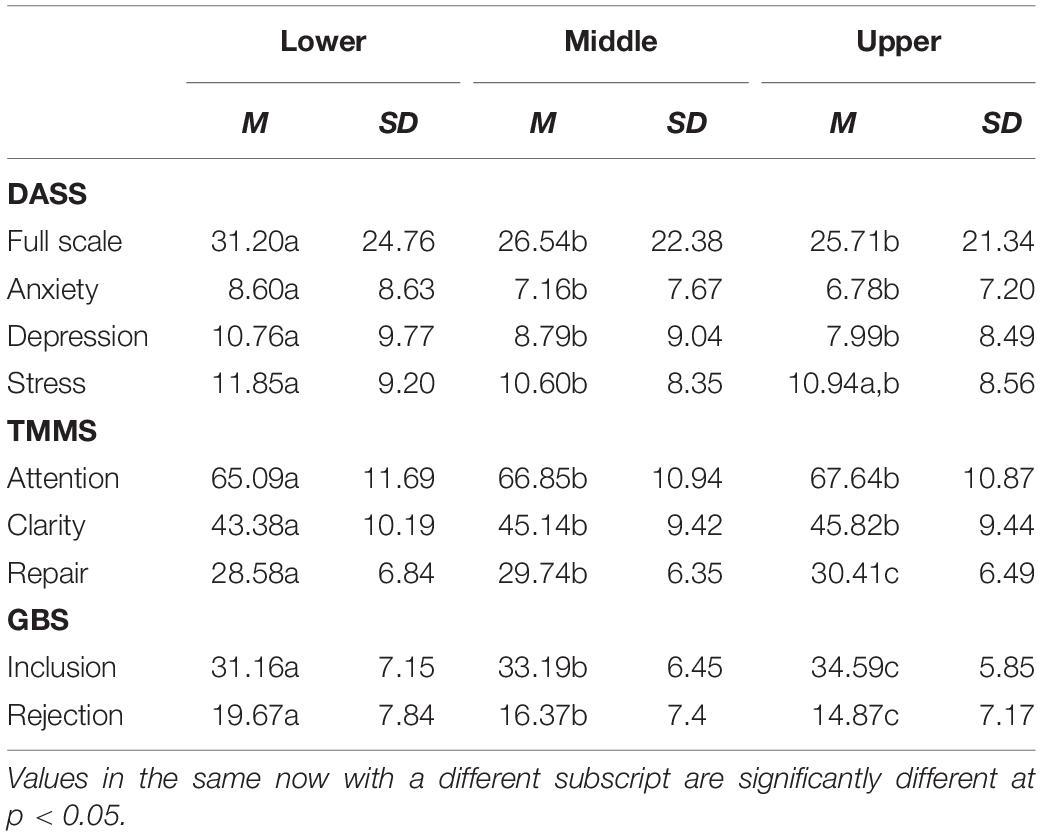
Table 4. Socioeconomic differences in Depression Anxiety Stress Scale (DASS), Trait Meta Mood Scale (TMMS), and General Belongingness Scale (GBS).
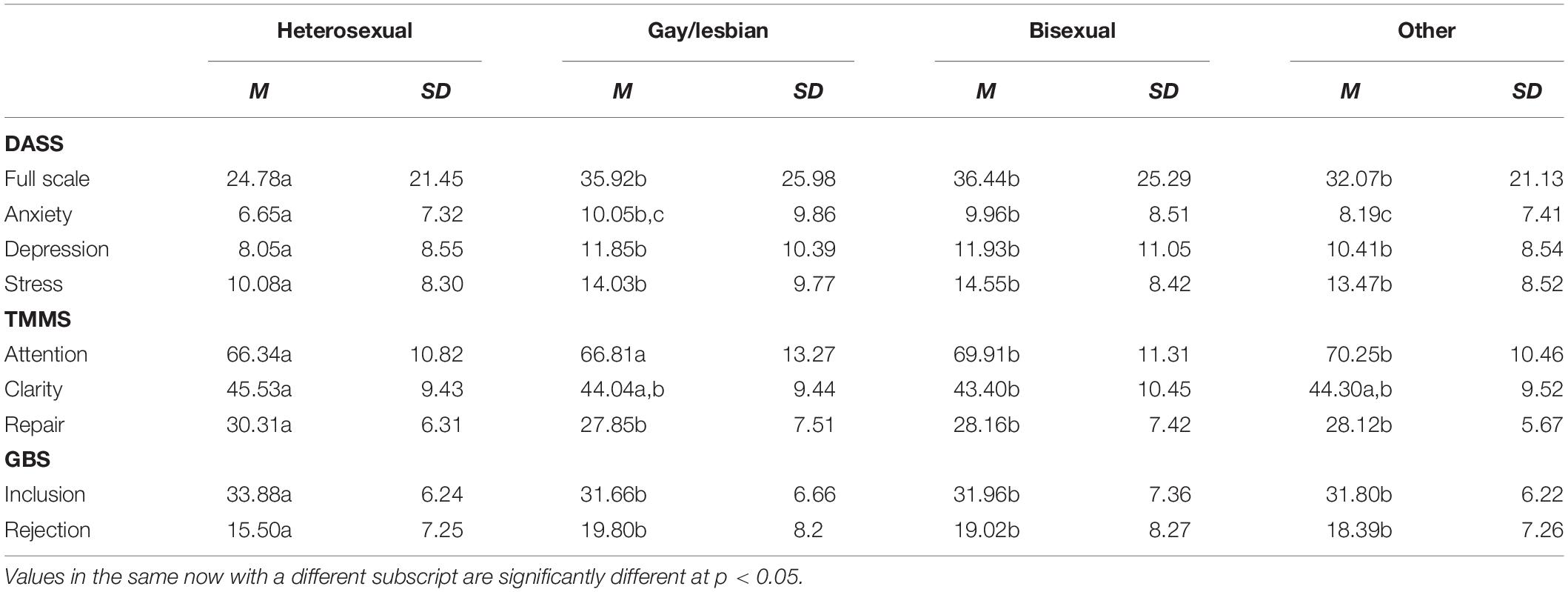
Table 5. Sexual orientation differences in Depression Anxiety Stress Scale (DASS), Trait Meta Mood Scale (TMMS), and General Belongingness Scale (GBS).
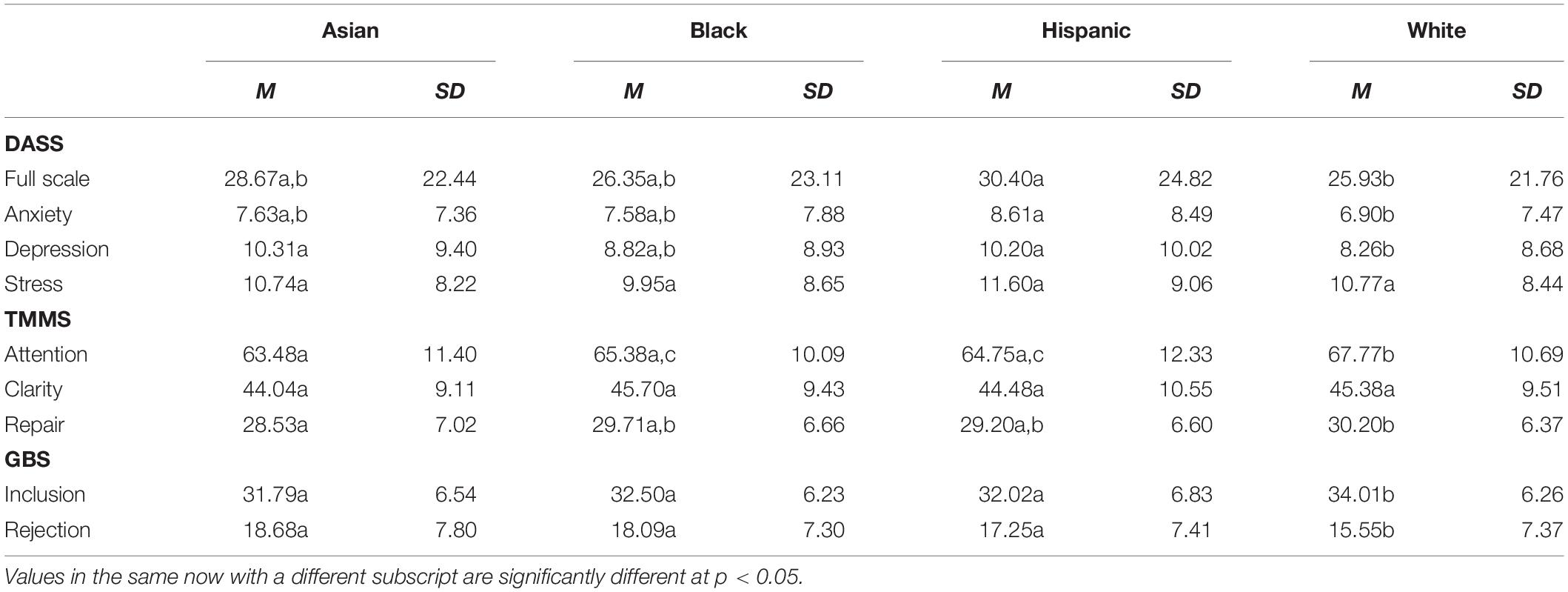
Table 6. Racial/ethnic differences in Depression Anxiety Stress Scale (DASS), Trait Meta Mood Scale (TMMS), and General Belongingness Scale (GBS).
Tables 7–9 show the results of a series of parallel mediation models conducted with PROCESS (Hayes, 2017). These models tested whether the relationship between each of the three TMMS subscales (Attention, Clarity, and Repair) and the DASS Full Scale measure of mental health symptoms was mediated by either or both of the GBS scales (Inclusion and Rejection). Thus, Model 1 (see Figure 1 for an illustration and Table 7 for details) tests whether the relationship between Attention and the DASS Full Scale is mediated by Inclusion, Rejection or both; Table 8 and Figure 2 show the same model, but with Clarity; and Table 9 and Figure 3 show the same model, but with Repair. Both the unstandardized and fully standardized coefficients are presented for the total effect of each indirect path, for each model. As per Hayes (2017), the fully standardized coefficients are reasonable measures of effect size, although some debate persists about how best to present effect sizes for more complex mediation models. The standardized coefficients for each indirect path represent the predicted change in DASS Full Scale (as measured in standard deviations) associated with a one standard deviation change in TMMS Attention, Clarity, or Repair (respectively).
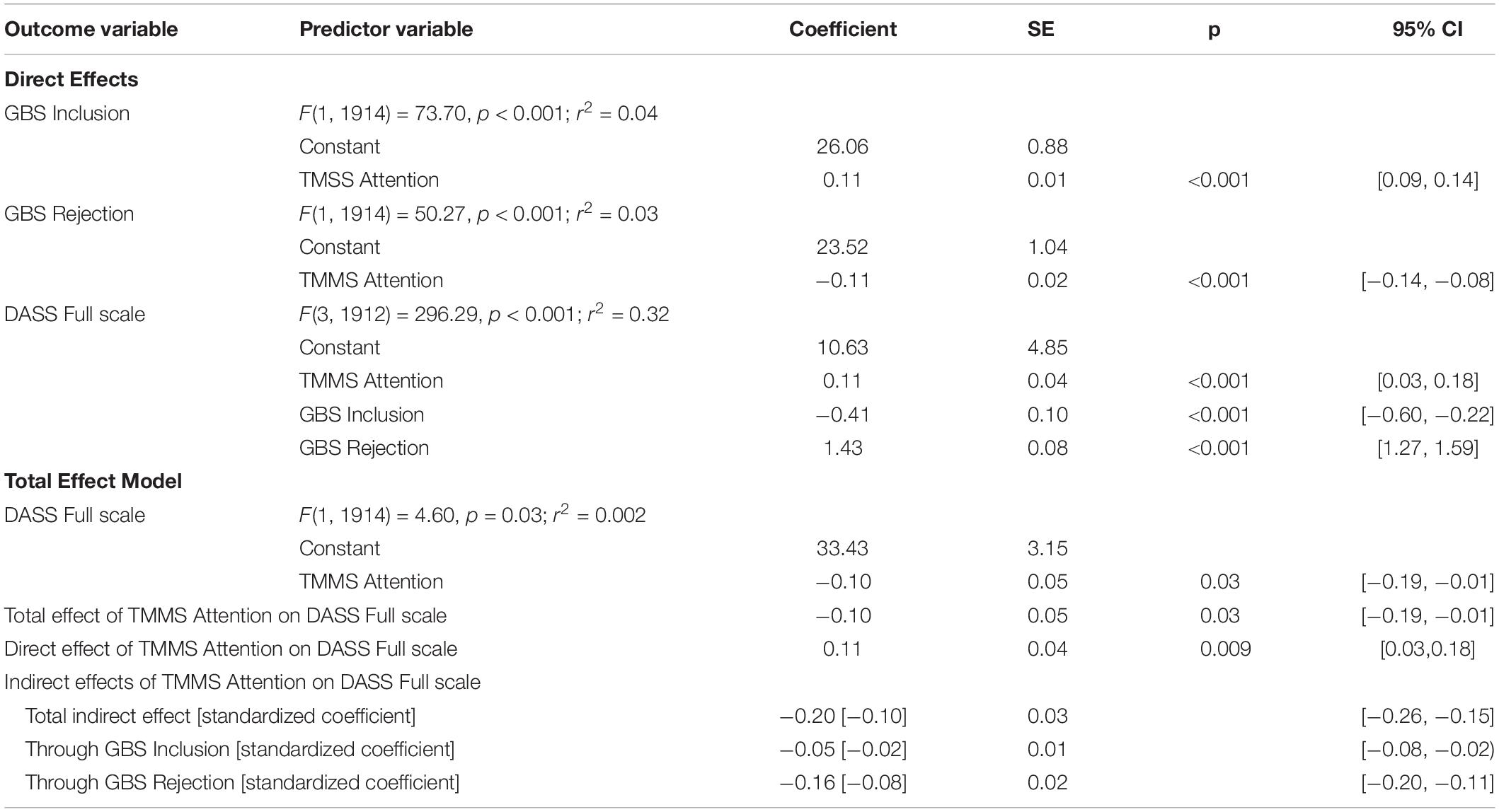
Table 7. Parallel mediation model of TMMS Attention predicting DASS Full scale, mediated by GBS Inclusion and Rejection.
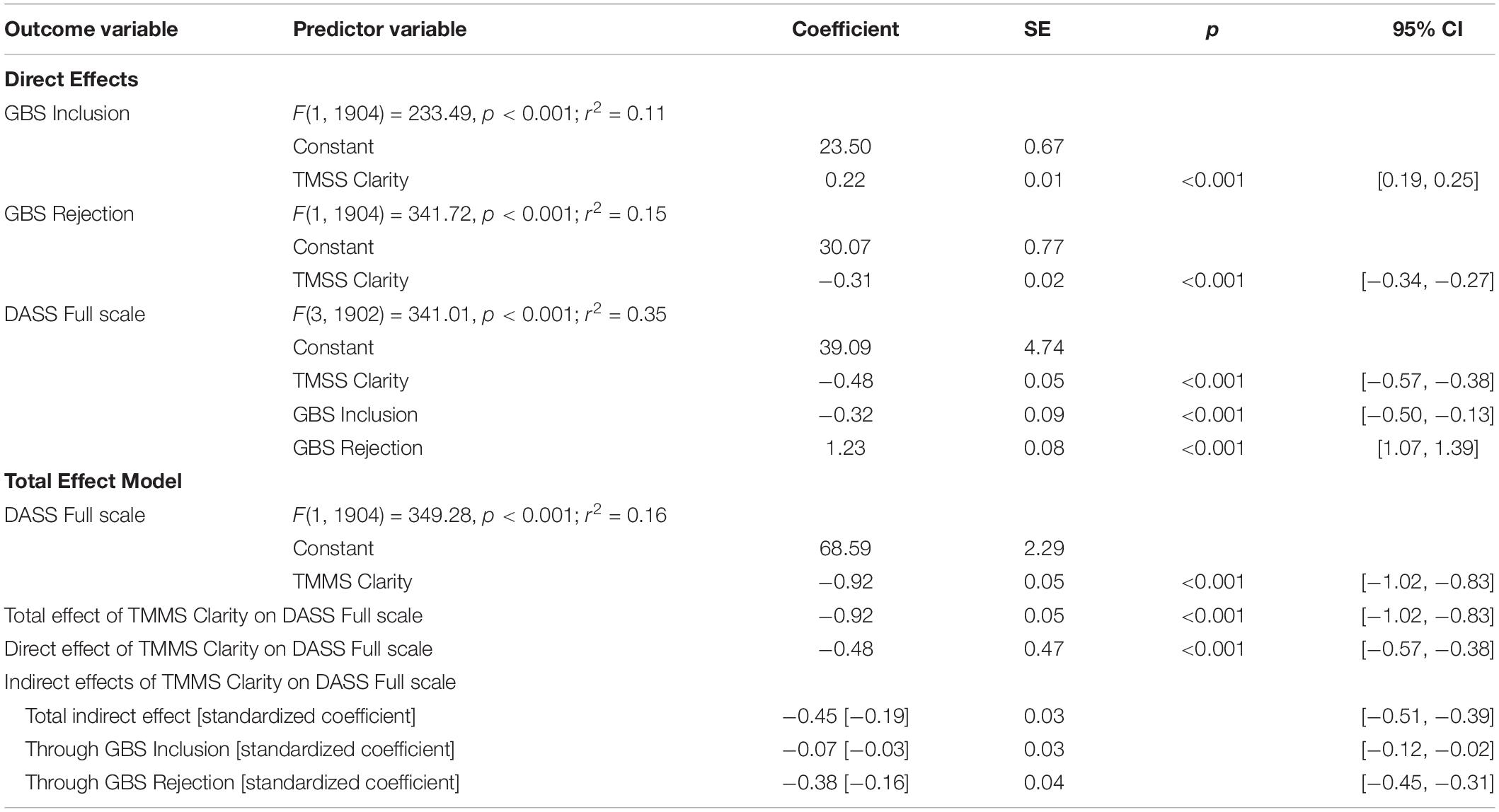
Table 8. Parallel mediation model of TMMS Clarity predicting DASS Full scale, mediated by GBS Inclusion and Rejection.
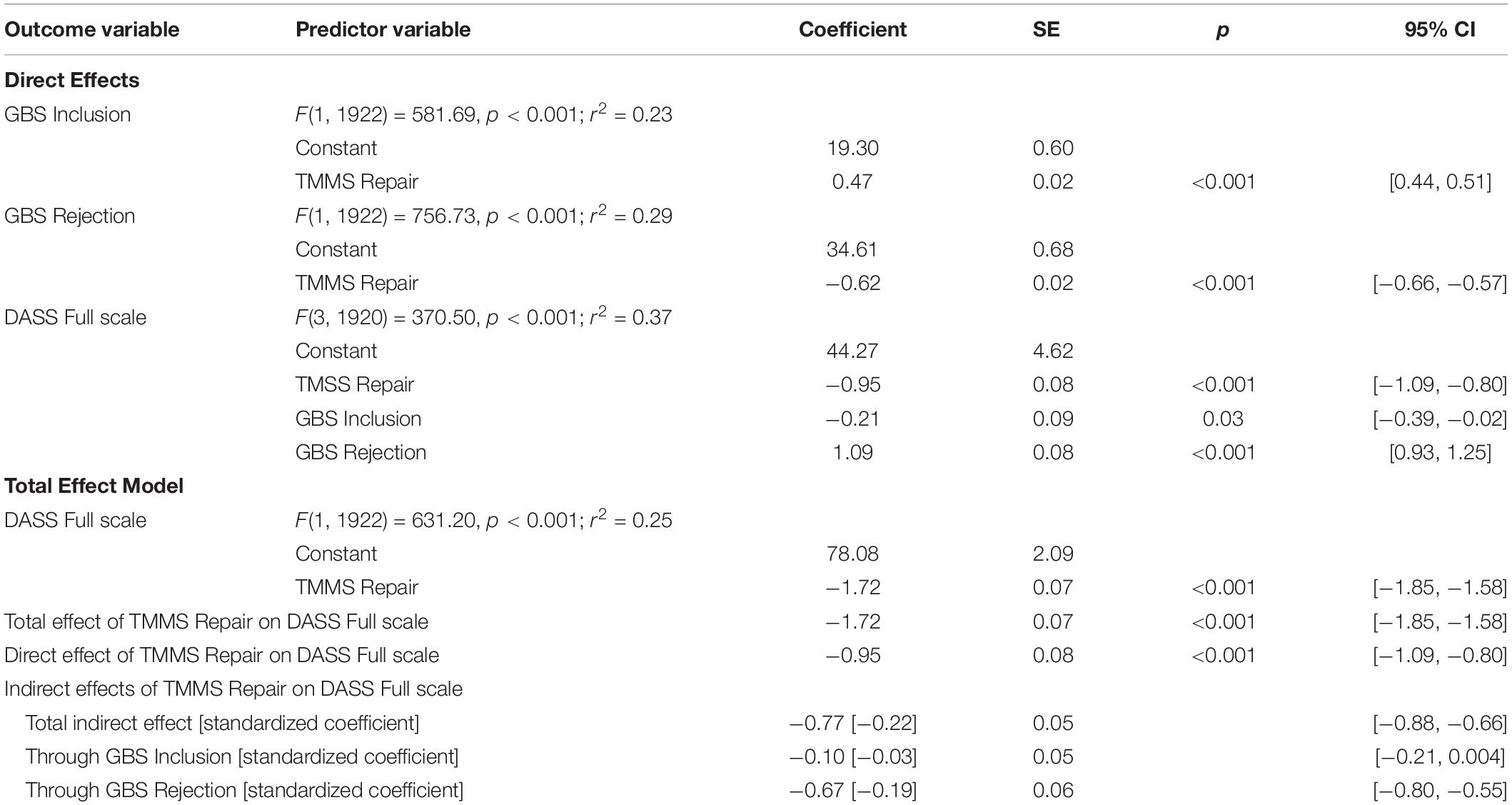
Table 9. Parallel mediation model of TMMS Repair predicting DASS Full scale, mediated by GBS Inclusion and Rejection.
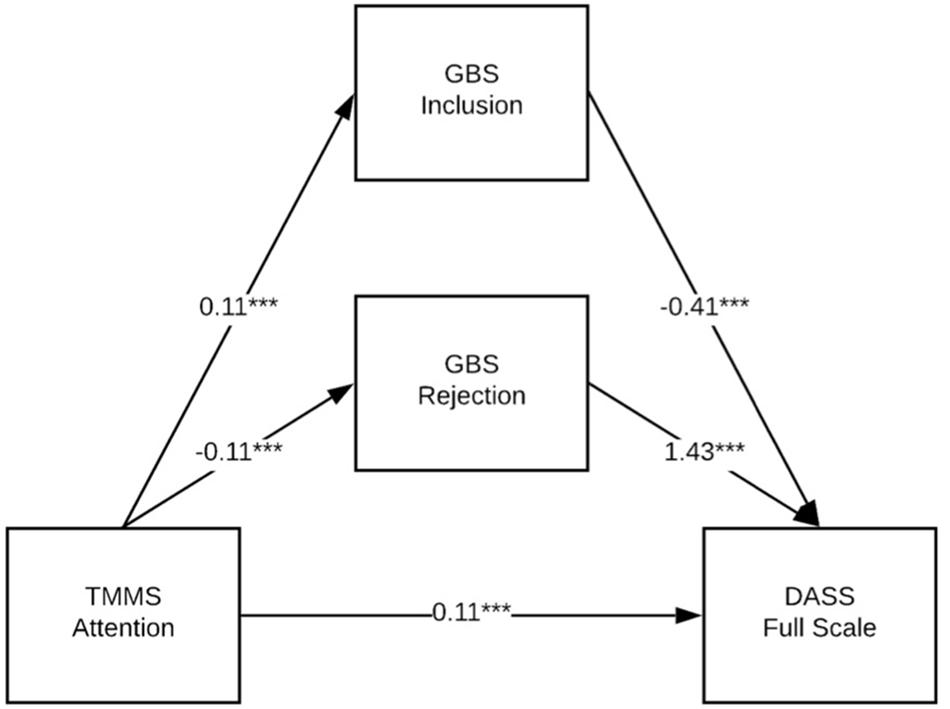
Figure 1. GBS Inclusion and Rejection partially mediate the relationship between TMMS Attention and DASS Full scale. *p < 0.05; **p < 0.01; ***p < 0.001.
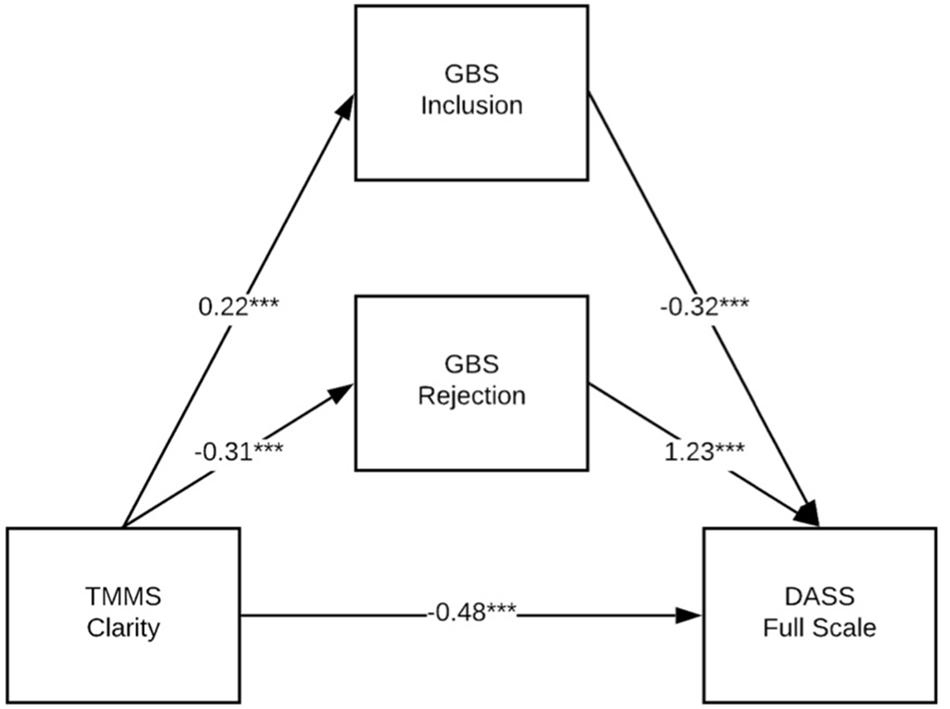
Figure 2. GBS Inclusion and Rejection partially mediate the relationship between TMMS Clarity and DASS Full scale. *p < 0.05; **p < 0.01; ***p < 0.001.
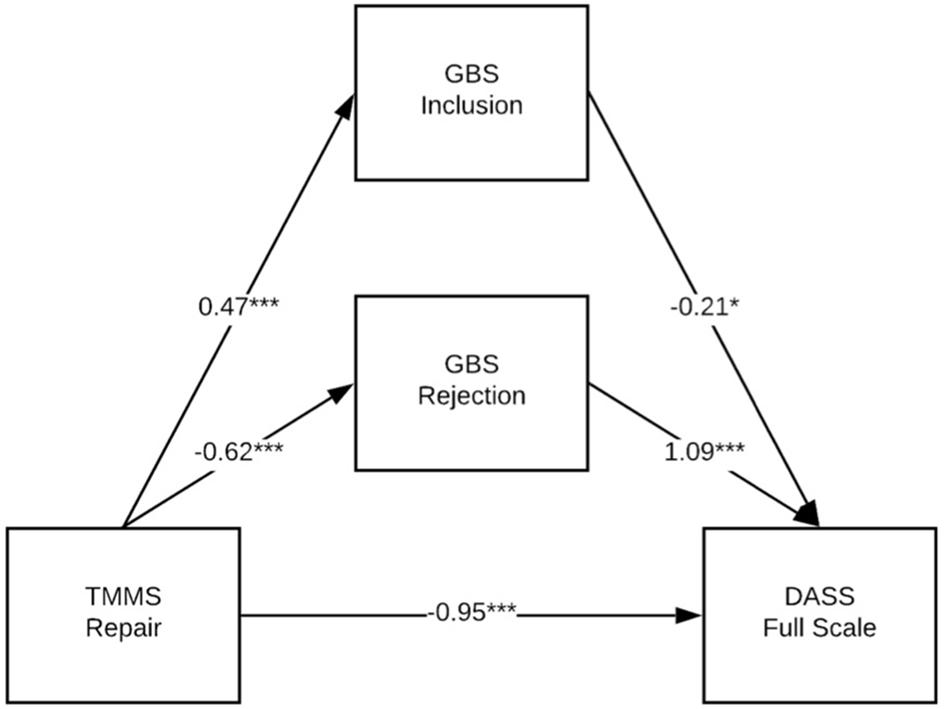
Figure 3. GBS Inclusion and Rejection partially mediate the relationship between TMMS Repair and DASS Full scale. *p < 0.05; **p< 0.01; ***p < 0.001.
All three models accounted for a significant portion of the variance in the outcome measure; see Tables 7–9 and Figures 1–3 for coefficients and model fit information. The 95% CI for the indirect path between TMMS Repair and DASS Full Scale through GBS Inclusion included zero, which suggests that the strength of that pathway is not of meaningful or statistically significant size. Note that all models reflect partial mediation, and that a protective indirect effect of Attention (through Inclusion and Rejection) is partially suppressed by a deleterious direct effect of Attention of mental health burden. Note that the size of this sample may reduce the interpretability of NHST measures of significance, and that the size and sign of the coefficients are more meaningful.
Discussion
This study sought to elucidate the association between EQ and adaptive functioning in college students. Specifically, the models tested whether sense of belongingness mediates the association between EQ and adaptation. We hypothesized that students with stronger EQ abilities would report higher levels of belongingness which, in turn, would be associated with better mental health. Conversely, we also expected that students with lower levels of EQ would be more likely to experience rejection which, in turn, would be linked to higher levels of depression, anxiety, and stress.
These results broadly supported our hypothesis: students with more EQ (as evidenced by higher scores on any or all of the subscales) experienced higher levels of belongingness (more inclusion and less rejection) which, in turn, was associated with lower overall mental health problems. The exception was the indirect pathway between TMMS Repair and DASS Full Scale through GBS Inclusion, which was not of meaningful size. While inclusion was found to be meaningful in predicting mental health, it was the experience of rejection that was the stronger predictor of mental health outcomes. Specifically, students with lower levels of EQ are experiencing higher levels of rejection, and it is rejection which has the most significant impact on the DASS full scale mental health outcome. These results implicitly support the modeling of inclusion and rejection as orthogonal scales, as per the GBS (Malone et al., 2012). The effects of rejection on depression in adolescent populations is well established (for a review see Platt et al., 2013). Our findings extend the existing research by demonstrating that among emerging adults, the experience of rejection is associated with higher levels of mental health problems. The experience of being included does have a protective effect, but, since high levels of inclusion and rejection can be experienced by the same person, working to improve inclusion is unlikely to be sufficient to reduce mental health burdens: the reduction of experience of rejection is likely to have a larger impact.
Implications
These findings have implications for applied work. Results from our mediation analyses suggested a strong link between perceived rejection and mental health problems. Such results tentatively suggest that intervention efforts could target students who are experiencing feelings of rejection or isolation within their college community. Once identified, these students could be targeted with additional supports, such as short-term counseling, to support well-being. Taking a preventative approach, campus initiatives that support regular and healthy student interactions should continue to receive funding such that they can be maximally effective. A focus on increasing students’ sense of belonging should also seek to lower experiences of rejection. Given that each of the scales of EQ was independently related to sense of belongingness, targeting and strengthening emotional intelligence would also be a potential avenue for prevention and intervention efforts. However, further research is needed to further elucidate the association between EQ, belongingness, and mental health in college samples. Such research should address both the differences in impact between the EQ subscales and explore the extent to which Attention, Clarity, and Repair may vary in their malleability. If, as these results suggest, they are each independently linked to important mental health outcomes, then a targeted intervention would be most effective if it targeted the aspect of EQ most susceptible to intentional change.
Limitations
Our results should be interpreted in the context of the study’s limitations. First, the study was based on student self-report, which has inherent and well-documented limitations. A second weakness relates to the representativeness of our sample; participants were recruited from two small, competitive liberal arts colleges thereby potentially limiting generalizability of study findings. Similarly, there might be systematic differences between those students who decided to complete the survey and those who chose not to participate. Lastly, data was collected at one timepoint, which limits our ability to make strong inferences about causality. Future research should recruit samples that are more representative of the overall college student population and consider using multi-informant assessments (e.g., friends, parents) to corroborate the self-report data. Longitudinal data collection could also help establish the causal relationship between the three study variables. These limitations notwithstanding, our findings expand what is known about college student well-being by suggesting that EQ and a sense of belongingness are related to mental health symptoms of college students.
Data Availability Statement
The datasets generated for this study will not be made publicly available in order to maintain confidentiality of the study participants. Requests to access the datasets should be directed to the corresponding author.
Ethics Statement
The studies involving human participants were reviewed and approved by the Middlebury College Institutional Review Board. The patients/participants provided their electronic informed consent to participate in this study.
Author Contributions
RM and MS contributed conception, design, and database organization. RM, MS, and VP contributed equally to analyses, draft of the manuscript as well as revisions, and approved the submitted version.
Funding
Research reported in this publication was supported by an Institutional Development Award (IDeA) from the National Institute of General Medical Sciences of the National Institutes of Health under grant number P20GM103449. Its contents are solely the responsibility of the authors and do not necessarily represent the official views of NIGMS or NIH. Additional support was provided by the Middlebury College research leave program.
Conflict of Interest
The authors declare that the research was conducted in the absence of any commercial or financial relationships that could be construed as a potential conflict of interest.
References
American College Health Association (2019). American College Health Association- National College Health Assessment II: Reference Group Executive Summary Spring 2019. Silver Spring, MD: American College Health Association.
Auerbach, R. P., Alonso, J., Axinn, W. G., Cuijpers, P., Ebert, D. D., Green, J. G. et al. (2016). Mental health disorders among college students in the World Health Organization World Mental Health Surveys. Psychol. Med. 46, 2955–2970.
Baumeister, R. F., and Leary, M. R. (1995). The need to belong: desire for interpersonal attachments as a fundamental human motivation. Psychol. Bull. 117, 497–529. doi: 10.1037/0033-2909.117.3.497
Baumeister, R. F., and Tice, D. M. (1990). Point-counterpoints: anxiety and social exclusion. J. Soc. Clin. Psychol. 9, 165–195. doi: 10.1521/jscp.1990.9.2.165
Brackett, M. A., Mayer, J. D., and Warner, R. M. (2004). Emotional intelligence and its relation to everyday behaviour. Pers. Individ. Diff. 36, 1387–1402. doi: 10.1016/s0191-8869(03)00236-8
Ciarrochi, J., Chan, A. Y., and Bajgar, J. (2001). Measuring emotional intelligence in adolescents. Pers. Individ. Diff. 31, 1105–1119. doi: 10.1016/s0191-8869(00)00207-5
Conley, C. S., Kirsch, A. C., Dickson, D. A., and Bryant, F. B. (2014). Negotiating the transition to college: developmental trajectories and gender differences in psychological functioning, cognitive-affective strategies, and social well-being. Emerg. Adulthood 2, 195–210. doi: 10.1177/2167696814521808
Conley, C. S., Travers, L. V., and Bryant, F. B. (2013). Promoting psychosocial adjustment and stress management in first-year college students: the benefits of engagement in a psychosocial wellness seminar. J. Am. Coll. Health 61, 75–86. doi: 10.1080/07448481.2012.754757
Costa, A., and Faria, L. (2015). The impact of emotional intelligence on academic achievement: a longitudinal study in portuguese secondary school. Learn. Individ. Diff. 37, 38–47. doi: 10.1016/j.lindif.2014.11.011
Drum, D. J., Brownson, C., Burton Denmark, A., and Smith, S. E. (2009). New data on the nature of suicidal crises in college students: shifting the paradigm. Prof. Psychol. Res. Pr. 40, 213–222. doi: 10.1037/a0014465
Dusselier, L., Dunn, B., Wang, Y., Shelley Ii, M. C., and Whalen, D. F. (2005). Personal, health, academic, and environmental predictors of stress for residence hall students. J. Am. Coll. Health 54, 15–24. doi: 10.3200/jach.54.1.15-24
Extremera, N., and Fernández-Berrocal, P. (2005). Perceived emotional intelligence and life satisfaction: predictive and incremental validity using the trait meta-mood scale. Pers. Individ. Diff. 39, 937–948. doi: 10.1016/j.paid.2005.03.012
Hayes, A. F. (2017). Introduction to Mediation, Moderation, and Conditional Process Analysis: A Regression-Based Approach. New York, NK: Guilford Publications.
Henry, J. D., and Crawford, J. R. (2005). The short-form version of the depression anxiety stress scales (DASS-21): construct validity and normative data in a large non-clinical sample. Br. J. Clin. Psychol. 44, 227–239. doi: 10.1348/014466505x29657
Hurst, C. S., Baranik, L. E., and Daniel, F. (2013). College student stressors: a review of the qualitative research. Stress Health 29, 275–285.
Kokkinos, C. M., and Kipritsi, E. (2012). The relationship between bullying, victimization, trait emotional intelligence, self-efficacy and empathy among preadolescents. Soc. Psychol. Educ. 15, 41–58. doi: 10.1007/s11218-011-9168-9
Leary, M. R. (1990). Responses to social exclusion: social anxiety, jealousy, loneliness, depression, and low self-esteem. J. Soc. Clin. Psychol. 9, 221–229. doi: 10.1521/jscp.1990.9.2.221
Lopes, P. N., Brackett, M. A., Nezlek, J. B., Schütz, A., Sellin, I., and Salovey, P. (2004). Emotional intelligence and social interaction. Pers. Soc. Psychol. Bull. 30, 1018–1034.
Lopes, P. N., Salovey, P., and Straus, R. (2003). Emotional intelligence, personality, and the perceived quality of social relationships. Pers. Individ. Diff. 35, 641–658. doi: 10.1016/s0191-8869(02)00242-8
Mahmoud, J. S. R., Staten, R. T., Hall, L. A., and Lennie, T. A. (2012). The relationship among young adult college students’ depression, anxiety, stress, demographics, life satisfaction, and coping styles. Issues Ment. Health Nurs. 33, 149–156. doi: 10.3109/01612840.2011.632708
Malone, G. P., Pillow, D. R., and Osman, A. (2012). The General belongingness Scale (GBS): assessing achieved belongingness. Pers. Individ. Diff. 52, 311–316. doi: 10.1016/j.paid.2011.10.027
Martins, A., Ramalho, N., and Morin, E. (2010). A comprehensive meta-analysis of the relationship between emotional Intelligence and health. Pers. Individ. Diff. 49, 554–564. doi: 10.1016/j.schres.2010.11.001
Mayer, J. D., Salovey, P. (1997). “What is emotional intelligence?” in Emotional Development and Emotional Intelligence: Implications for Educators, eds Salovey, P., and Sluyter, D. (New York, NY: Basic Books), 3–31.
Mayer, J. D., Salovey, P., and Caruso, D. R. (2004). Emotional intelligence: theory, findings, and implications. Psychol. Inq. 15, 197–215. doi: 10.1207/s15327965pli1503_02
McAdams, D. P., and Bryant, F. B. (1987). Intimacy motivation and subjective mental health in a nationwide sample. J. Pers. 55, 395–413. doi: 10.1111/j.1467-6494.1987.tb00444.x
Palmer, B., Gignac, G., Bates, T., and Stough, C. (2003). Examining the structure of the trait meta−mood scale. Aust. J. Psychol. 55, 154–158. doi: 10.1080/13607863.2019.1673308
Parker, J. D. A., Hogan, M. J., Eastabrook, J. M., Oke, A., and Wood, L. M. (2006). Emotional intelligence and student retention: predicting the successful transition from high school to university. Pers. Individ. Diff. 41, 1329–1336. doi: 10.1016/j.paid.2006.04.022
Parker, J. D. A., Summerfeldt, L. J., Hogan, M. J., and Majeski, S. A. (2004). Emotional intelligence and academic success: examining the transition from high school to university. Pers. Individ. Diff. 36, 163–172. doi: 10.1016/s0191-8869(03)00076-x
Perlini, A. H., and Halverson, T. R. (2006). Emotional intelligence in the national hockey league. Can. J. Behav. Sci. 38, 109–119.
Platt, B., Kadosh, K. C., and Lau, J. Y. F. (2013). The role of peer rejection: peer rejection and adolescent depression. Depress. Anxiety 30, 809–821. doi: 10.1002/da.22120
Pratt, M. W., Hunsberger, B., Pancer, S. M., Alisat, S., Bowers, C., Mackey, K., et al. (2000). Facilitating the transition to university: evaluation of a social support discussion intervention program. J. Coll. Stud. Dev. 41, 427–441.
Raymond, J. M., and Sheppard, K. (2018). Effects of peer mentoring on nursing students’ perceived stress, sense of belonging, self-efficacy and loneliness. J. Nurs. Educ. Pract. 8, 16–23.
Ruiz-Aranda, D., Castillo, R., Salguero, J. M., Cabello, R., Fernández-Berrocal, P., and Balluerka, N. (2012). Short-and midterm effects of emotional intelligence training on adolescent mental health. J. Adolesc. Health 51, 462–467. doi: 10.1016/j.jadohealth.2012.02.003
Salovey, P., Mayer, J. D., Goldman, S. L., Turvey, C., and Palfai, T. P. (1995). “Emotional attention, clarity, and repair: exploring emotional intelligence using the trait meta-mood scale,” in Emotion, Disclosure, & Health, ed. J. W. Pennebaker, (Washington, DC:American Psychological Association), 125–154 doi: 10.1037/10182-006
Sánchez-Álvarez, N., Extremera, N., and Fernández-Berrocal, P. (2015). Maintaining life satisfaction in adolescence: affective mediators of the influence of perceived emotional intelligence on overall life satisfaction judgments in a two-year longitudinal study. Front. Psychol. 6:1892. doi: 10.3389/fpsyg.2015.01892
Schutte, N. S., Malouff, J. M., Hall, L. E., Haggerty, D. J., Cooper, J. T., and Golden, C. J. (1998). Development and validation of a measure of emotional intelligence. Pers. Individ. Diff. 25, 167–177.
Selkie, E. M., Kota, R., Chan, Y.-F., and Moreno, M. (2015). Cyberbullying, depression, and problem alcohol use in female college students: a multisite study. Cyberpsychol. Behav. Soc. Netw. 18, 79–86. doi: 10.1089/cyber.2014.0371
Stebleton, M. J., Soria, K. M., and Huesman, R. L. Jr. (2014). First−generation students’ sense of belonging, mental health, and use of counseling services at public research universities. J. Coll. Couns. 17, 6–20. doi: 10.1002/j.2161-1882.2014.00044.x
Williamson, T. J., Thomas, K. S., Eisenberger, N.I, and Stanton, A. L. (2018). Effects of social exclusion on cardiovascular and affective reactivity to a socially evaluative stressor. Int. J. Behav. Med. 25, 410–420. doi: 10.1007/s12529-018-9720-5
Keywords: mental health, college students, emotional intelligence, belonging, depression, anxiety, stress, rejection
Citation: Moeller RW, Seehuus M and Peisch V (2020) Emotional Intelligence, Belongingness, and Mental Health in College Students. Front. Psychol. 11:93. doi: 10.3389/fpsyg.2020.00093
Received: 22 September 2019; Accepted: 13 January 2020;
Published: 31 January 2020.
Edited by:
Antonella Granieri, University of Turin, ItalyReviewed by:
Claire Houtsma, University of Southern Mississippi, United StatesViola Sallay, University of Szeged, Hungary
Copyright © 2020 Moeller, Seehuus and Peisch. This is an open-access article distributed under the terms of the Creative Commons Attribution License (CC BY). The use, distribution or reproduction in other forums is permitted, provided the original author(s) and the copyright owner(s) are credited and that the original publication in this journal is cited, in accordance with accepted academic practice. No use, distribution or reproduction is permitted which does not comply with these terms.
*Correspondence: Robert W. Moeller, cm1vZWxsZXJAbWlkZGxlYnVyeS5lZHU=
 Robert W. Moeller
Robert W. Moeller Martin Seehuus
Martin Seehuus Virginia Peisch
Virginia Peisch